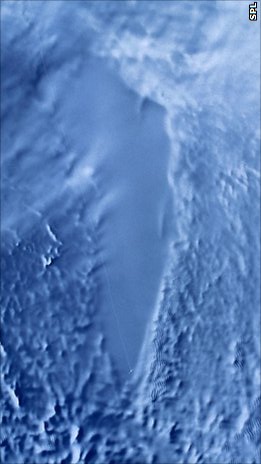|
Ancient Lake
An ancient lake is a lake that has consistently carried water for more than one million years. Twelve of the 20 ancient lakes have existed for more than 2.6 million years, the full Quaternary period. Ancient lakes continue to persist due to plate tectonics in an active rift zone. This active rift zone creates lakes that are extremely deep and difficult to naturally fill with sediment. Due to the prolonged life of ancient lakes, they serve as models for isolated evolutionary traits and speciation. Most of the world's bodies of water are less than 18,000 years old. There are only 20 ancient lakes over 1 million years old. Lake Baikal is often considered the oldest, as clear evidence shows that it is 25–30 million years old. Lake Zaysan may be even older, of Cretaceous origin and at least 66 million years old (most likely around 70 million years), but its exact age is controversial and labeled with some uncertainty. Another contender for oldest is Lake Maracaibo, estimated to be ... [...More Info...] [...Related Items...] OR: [Wikipedia] [Google] [Baidu] |
Zaysan
Zaysan or Zaisan (Cyrillic Alphabet, Cyrillic: Зайсан) can refer to: *Lake Zaysan in eastern Kazakhstan *Zaysan (town) or Zaisan, Kazakhstan *Zaysan District in East Kazakhstan Province, Kazakhstan *Zaisan Memorial in Ulaanbaatar, Mongolia {{disambig, geo ... [...More Info...] [...Related Items...] OR: [Wikipedia] [Google] [Baidu] |
Baikal Rift Zone
The Baikal Rift Zone is a series of continental rifts centered beneath Lake Baikal in southeastern Russia. Current strain in the rifts tends to be extending with some shear movement. A series of basins form along the zone for more than , creating a rift valley. The rifts form between the Eurasian Plate to the west and the Amur Plate to the east. Structures To the northwest of the rifts is the Siberian Craton, on the Eurasian Plate. The Sayan-Baikal and Mongolia-Okhotsk mobile belts are formations to the southeast of the rifts; beyond the Sayan-Baikal fold belt is the Amur Plate. Basins form along the rift. There are three basins in the area, the South Basin, Central Basin, and North Basin. In the North, half-grabens form smaller basins, such as the North Baikal Basin, and the Chara-Tokka Basin. The Central Basin is the deepest in the rift system. The largest fault it contains is the Morskiy Fault; however, another fault, the Primorsky is becoming the primary fault in the r ... [...More Info...] [...Related Items...] OR: [Wikipedia] [Google] [Baidu] |
Adaptive Radiation
In evolutionary biology, adaptive radiation is a process in which organisms diversify rapidly from an ancestral species into a multitude of new forms, particularly when a change in the environment makes new resources available, alters biotic interactions or opens new environmental niches. Starting with a single ancestor, this process results in the speciation and phenotypic adaptation of an array of species exhibiting different morphological and physiological traits. The prototypical example of adaptive radiation is finch speciation on the Galapagos ("Darwin's finches"), but examples are known from around the world. Characteristics Four features can be used to identify an adaptive radiation: #A common ancestry of component species: specifically a ''recent'' ancestry. Note that this is not the same as a monophyly in which ''all'' descendants of a common ancestor are included. #A phenotype-environment correlation: a ''significant'' association between environments and the mor ... [...More Info...] [...Related Items...] OR: [Wikipedia] [Google] [Baidu] |
Sexual Selection
Sexual selection is a mechanism of evolution in which members of one sex mate choice, choose mates of the other sex to mating, mate with (intersexual selection), and compete with members of the same sex for access to members of the opposite sex (intrasexual selection). These two forms of selection mean that some individuals have greater reproductive success than others within a population, for example because they are more Animal sexual behaviour, attractive or prefer more attractive partners to produce offspring. Successful males benefit from frequent mating and monopolizing access to one or more fertile females. Females can maximise the return on the energy they invest in reproduction by selecting and mating with the best males. The concept was first articulated by Charles Darwin who wrote of a "second agency" other than natural selection, in which competition between mate candidates could lead to speciation. The theory was given a mathematical basis by Ronald Fisher in the e ... [...More Info...] [...Related Items...] OR: [Wikipedia] [Google] [Baidu] |
Divergent Boundary
In plate tectonics, a divergent boundary or divergent plate boundary (also known as a constructive boundary or an extensional boundary) is a linear feature that exists between two List of tectonic plates, tectonic plates that are moving away from each other. Divergent boundaries within continents initially produce rift (geology), rifts, which eventually become rift valleys. Most active divergent plate boundaries occur between Oceanic crust, oceanic plates and exist as mid-oceanic ridges. Current research indicates that complex convection within the Earth's mantle allows material to rise to the base of the lithosphere beneath each divergent plate boundary. This supplies the area with huge amounts of heat and a reduction in pressure that melts Rock (geology), rock from the asthenosphere (or upper mantle (Earth), upper mantle) beneath the rift area, forming large flood basalt or lava flows. Each eruption occurs in only a part of the plate boundary at any one time, but when it does ... [...More Info...] [...Related Items...] OR: [Wikipedia] [Google] [Baidu] |
Rift Valley
A rift valley is a linear shaped lowland between several highlands or mountain ranges produced by the action of a geologic rift. Rifts are formed as a result of the pulling apart of the lithosphere due to extensional tectonics. The linear depression may subsequently be further deepened by the forces of erosion. More generally the valley is likely to be filled with sedimentary deposits derived from the rift flanks and the surrounding areas. In many cases rift lakes are formed. One of the best known examples of this process is the East African Rift. On Earth, rifts can occur at all elevations, from the sea floor to plateaus and mountain ranges in continental crust or in oceanic crust. They are often associated with a number of adjoining subsidiary or co-extensive valleys, which are typically considered part of the principal rift valley geologically. Earth's rift valleys The most extensive rift valley is located along the crest of the mid-ocean ridge system and is the result ... [...More Info...] [...Related Items...] OR: [Wikipedia] [Google] [Baidu] |
Subglacial Lake
A subglacial lake is a lake that is found under a glacier, typically beneath an ice cap or ice sheet. Subglacial lakes form at the boundary between ice and the underlying bedrock, where liquid water can exist above the lower melting point of ice under high pressure. Over time, the overlying ice gradually melts at a rate of a few millimeters per year. Meltwater flows from regions of high to low hydraulic pressure under the ice and pools, creating a body of liquid water that can be isolated from the external environment for millions of years. Since the first discoveries of subglacial lakes under the Antarctic Ice Sheet, more than 400 subglacial lakes have been discovered in Antarctica, beneath the Greenland Ice Sheet, and under Iceland's Vatnajökull ice cap. Subglacial lakes contain a substantial proportion of Earth's liquid freshwater, with the volume of Antarctic subglacial lakes alone estimated to be about 10,000 km3, or about 15% of all liquid freshwater on Earth. As ... [...More Info...] [...Related Items...] OR: [Wikipedia] [Google] [Baidu] |
Glacial Lake
A glacial lake is a body of water with origins from glacier activity. They are formed when a glacier erodes the land and then melts, filling the depression created by the glacier. Formation Near the end of the last glacial period, roughly 10,000 years ago, glaciers began to retreat. A retreating glacier often left behind large deposits of ice in hollows between drumlins or hills. As the ice age ended, these melted to create lakes. These lakes are often surrounded by drumlins, along with other evidence of the glacier such as moraines, eskers and erosional features such as glacial striations, striations and chatter marks. These lakes are clearly visible in aerial photos of landforms in regions that were glaciated during the last ice age. The formation and characteristics of glacial lakes vary between location and can be classified into glacial erosion lake, ice-blocked lake, moraine-dammed lake, other glacial lake, supraglacial lake, and subglacial lake. Glacial lakes and chan ... [...More Info...] [...Related Items...] OR: [Wikipedia] [Google] [Baidu] |
Volcanic Crater Lake
A volcanic crater lake is a lake in a volcanic crater, crater that was formed by explosive eruption, explosive activity or a caldera, collapse during a types of volcanic eruptions, volcanic eruption. Formation Lakes in calderas fill large craters formed by the collapse of a volcano during an eruption. Lakes in maars fill medium-sized craters where an eruption deposited debris around a vent. Crater lakes form as the created depression, within the Rim (craters), crater rim, is filled by water. The water may come from Precipitation (meteorology), precipitation, groundwater circulation (often Hot Spring, hydrothermal fluids in the case of volcanic craters) or melted ice. Its level rises until an equilibrium is reached between the rates of incoming and outgoing water. Sources of water loss singly or together may include evaporation, subsurface seepage, and, in places, surface leakage or overflow when the lake level reaches the lowest point on its rim. At such a saddle location, the u ... [...More Info...] [...Related Items...] OR: [Wikipedia] [Google] [Baidu] |
Oxbow Lake
An oxbow lake is a U-shaped lake or stream pool, pool that forms when a wide meander of a river is meander cutoff, cut off, creating a free-standing body of water. The word "oxbow" can also refer to a U-shaped bend in a river or stream, whether or not it is cut off from the main stream. It takes its name from an oxbow which is part of a harness for oxen to pull a plough or cart. In South Texas, oxbows left by the Rio Grande are called ''resaca (channel), resacas''. In Australia, oxbow lakes are called billabongs. Geology An oxbow lake forms when a meandering river erodes through the neck of one of its meanders. This takes place because meanders tend to grow and become more curved over time. The river then follows a shorter course that bypasses the meander. The entrances to the abandoned meander eventually silt up, forming an oxbow lake. Oxbow lakes are stillwater lakes, with no current flowing through them, which causes the lake bed to gradually accumulate silt, becoming a ... [...More Info...] [...Related Items...] OR: [Wikipedia] [Google] [Baidu] |
Salt Lake
A salt lake or saline lake is a landlocked body of water that has a concentration of salts (typically sodium chloride) and other dissolved minerals significantly higher than most lakes (often defined as at least three grams of salt per liter). In some cases, salt lakes have a higher concentration of salt than sea water; such lakes can also be termed hypersaline lake, and may also be pink lakes on account of their color. An alkalic salt lake that has a high content of carbonate is sometimes termed a soda lake. Salt lakes are classified according to salinity levels. The formation of these lakes is influenced by processes such as evaporation and deposition. Salt lakes face serious conservation challenges due to climate change, pollution and water diversion. Classification The primary method of classification for salt lakes involves assessing the chemical composition of the water within the lakes, specifically its salinity, pH, and the dominant ions present. Subsaline Sub ... [...More Info...] [...Related Items...] OR: [Wikipedia] [Google] [Baidu] |
Landslide
Landslides, also known as landslips, rockslips or rockslides, are several forms of mass wasting that may include a wide range of ground movements, such as rockfalls, mudflows, shallow or deep-seated slope failures and debris flows. Landslides occur in a variety of environments, characterized by either steep or gentle slope gradients, from mountain ranges to coastal cliffs or even underwater, in which case they are called submarine landslides. Gravity is the primary driving force for a landslide to occur, but there are other factors affecting slope stability that produce specific conditions that make a slope prone to failure. In many cases, the landslide is triggered by a specific event (such as heavy rainfall, an earthquake, a slope cut to build a road, and many others), although this is not always identifiable. Landslides are frequently made worse by human development (such as urban sprawl) and resource exploitation (such as mining and deforestation). Land degradation freque ... [...More Info...] [...Related Items...] OR: [Wikipedia] [Google] [Baidu] |








